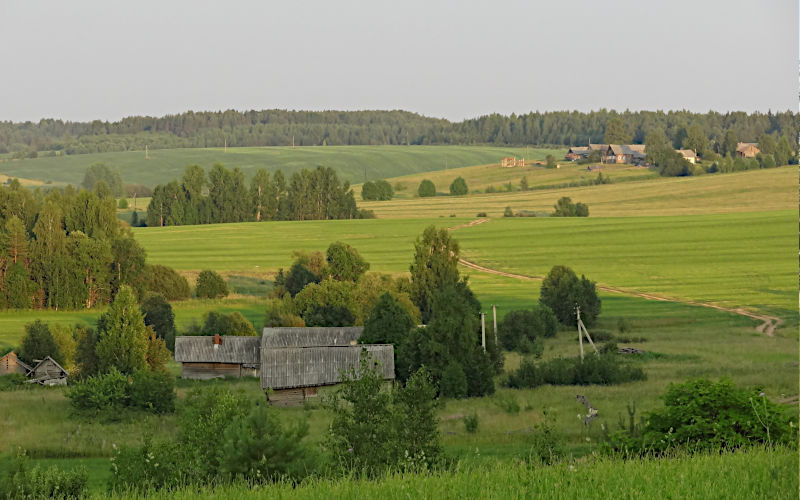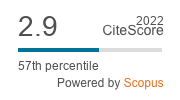Multiscale Organization of Landscape Structure in the Middle Taiga of European Russia
DOI:
https://doi.org/10.3097/LO.201966Keywords:
scale, hierarchy, geocomponent, interaction, response surface regression, neighborhood, landform, emergent effectAbstract
Dominant landscape-ecological models either focus on the hierarchical organization of a single phenomenon or describe relations at a single hierarchical level. We proposed the tool MALS (Multiscale Analysis of Landscape Structure) to reveal multiple independent hierarchies based on the interactions between properties of relief, soils and vegetation and tested it on the example of the middle-taiga landscape in European Russia. Morphological properties of soils and abundance of plant species were measured in operational territorial units. Multidimensional scaling was used to reveal ecological drivers. Combinations of landforms from DEM were used to describe spatial heterogeneity in the higher-order geosystems. Response surface regression was applied to relate soils and vegetation to each other and to relief of several hypothetic higher-order geosystems. Spatial extent of a higher-order geosystem was determined from the series of equations. Then we compared contributions of external (inter-level) and internal (intra-level) interactions to spatial variability of soils and vegetation. Herbs, low shrubs, and morphologic soil properties turned out to be controlled mainly by the geosystems with the linear size 1200 m, while trees, shrubs, and sediments – by the geosystems with size 2000 m. From 2 to 5 levels of the higher-order geosystems should be considered in order to obtain the proper explanation of spatial heterogeneity.
References
Angelstam, P., Grodzynskyi, M., Andersson, K., Axelsson, R., Elbakidze, M., Khoroshev, A., . . . Naumov, V. (2013). Measurement, collaborative learning and research for sustainable use of ecosystem services: Landscape concepts and europe as laboratory. Ambio, 42(2), 129-145. doi:10.1007/s13280-012-0368-0
Armand, A. D., & Targul'yan, V. O. (1976). Some fundamental limitations on experimentation and model-building in geography. Soviet Geography, 17, 197-206.
Avessalomova, I. A., Khoroshev, A. V., & Savenko, A. V. (2016). Barrier function of floodplain and riparian landscapes in river runoff formation. Riparian zones: Characteristics, management practices and ecological impacts (pp. 181-210)
Bastian, O., Grunewald, K., & Khoroshev, A. V. (2015). The significance of geosystem and landscape concepts for the assessment of ecosystem services: Exemplified in a case study in russia. Landscape Ecology, 30(7), 1145-1164. doi:10.1007/s10980-015-0200-x
Berg, L. S. (1915). The subject and tasks of geography. Izvestiya Russkogo Geograficheskogo Obshchestva, 51(9), 463-475.
Bolstad, P. V., Swank, W., & Vose, J. (1998). Predicting southern appalachian overstory vegetation with digital terrain data. Landscape Ecology, 13(5), 271-283. doi:10.1023/A:1008060508762
Borcard, D., & Legendre, P. (2002). All-scale spatial analysis of ecological data by means of principal coordinates of neighbour matrices. Ecological Modelling, 153(1-2), 51-68. doi:10.1016/S0304-3800(01)00501-4
Burnett, C., & Blaschke, T. (2003). A multi-scale segmentation/object relationship modelling methodology for landscape analysis. Ecological Modelling, 168(3), 233-249. doi:10.1016/S0304-3800(03)00139-X
Carlile, D. W., Skalski, J. R., Batker, J. E., Thomas, J. M., & Cullinan, V. I. (1989). Determination of ecological scale. Landscape Ecology, 2(4), 203-213. doi:10.1007/BF00125091
Chang, C. -., Lee, P. -., Bai, M. -., & Lin, T. -. (2006). Identifying the scale thresholds for field-data extrapolation via spatial analysis of landscape gradients. Ecosystems, 9(2), 200-214. doi:10.1007/s10021-005-0095-5
Couteron, P., Barbier, N., & Gautier, D. (2006). Textural ordination based on fourier spectral decomposition: A method to analyze and compare landscape patterns. Landscape Ecology, 21(4), 555-567. doi:10.1007/s10980-005-2166-6
Cox, T. F., & Cox, M. A. A. (1994). Multidimensional Scaling,
Cross, A., & Perakis, S. S. (2011). Complementary models of tree species-soil relationships in old-growth temperate forests. Ecosystems, 14(2), 248-260. doi:10.1007/s10021-010-9407-5
Cushman, S. A., & Huettmann, F. (2010). Spatial complexity, informatics, and wildlife conservation. Spatial complexity, informatics, and wildlife conservation (pp. 1-458) doi:10.1007/978-4-431-87771-4
Cushman, S. A., & McGarigal, K. (2002). Hierarchical, multi-scale decomposition of species-environment relationships. Landscape Ecology, 17(7), 637-646. doi:10.1023/A:1021571603605
Davis, J. C. (1986). Statistics and Data Analysis in Geology,
de Vasconcelos, M. J. P., Zeigler, B. P., & Graham, L. A. (1993). Modeling multi-scale spatial ecological processes under the discrete event systems paradigm. Landscape Ecology, 8(4), 273-286. doi:10.1007/BF00125133
Delcourt, H. R., Delcourt, P. A., & Webb III, T. (1982). Dynamic plant ecology: The spectrum of vegetational change in space and time. Quaternary Science Reviews, 1(3), 153-175. doi:10.1016/0277-3791(82)90008-7
Dorner, B., Lertzman, K., & Fall, J. (2002). Landscape pattern in topographically complex landscapes: Issues and techniques for analysis. Landscape Ecology, 17(8), 729-743. doi:10.1023/A:1022944019665
Drǎguţ, L., Walz, U., & Blaschke, T. (2010). The third and fourth dimensions of landscape: Towards conceptual models of topographically complex landscapes. Landscape Online, 22(1), 1-10. doi:10.3097/LO.201022
Fletcher, R. J., Jr., McCleery, R. A., Greene, D. U., & Tye, C. A. (2016). Integrated models that unite local and regional data reveal larger-scale environmental relationships and improve predictions of species distributions. Landscape Ecology, 31(6), 1369-1382. doi:10.1007/s10980-015-0327-9
Haila, Y. (2002). Scaling environmental issues: Problems and paradoxes. Landscape and Urban Planning, 61(2-4), 59-69. doi:10.1016/S0169-2046(02)00102-0
Hall, O., Hay, G. J., Bouchard, A., & Marceau, D. J. (2004). Detecting dominant landscape objects through multiple scales: An integration of object-specific methods and watershed segmentation. Landscape Ecology, 19(1), 59-76. doi:10.1023/B:LAND.0000018371.43447.1f
Hoechstetter, S., Walz, U., Dang, L. H., & Thinh, N. X. (2008). Effects of topography and surface roughness in analyses of landscape structure - A proposal to modify the existing set of landscape metrics. Landscape Online, 3(1), 1-14. doi:10.3097/LO.200803
Iggy Litaor, M., Seastedt, T. R., & Walker, D. A. (2002). Spatial analysis of selected soil attributes across an alpine topographic/snow gradient. Landscape Ecology, 17(1), 71-85. doi:10.1023/A:1015216400909
Kachanoski, R. G. (1988). Processes in soil-from pedon to landscape. SCOPE 35.Scales and Global Change: Spatial and Temporal Variability in Biospheric and Geospheric Processes,
Kennedy, R. S. H., Spies, T. A., & Gregory, M. J. (2008). Relationships of dead wood patterns with biophysical characteristics and ownership according to scale in coastal oregon, USA. Landscape Ecology, 23(1), 55-68. doi:10.1007/s10980-007-9164-9
Khoroshev, A. V. (2003). Spatial pattern of the landscape as a function of a block structure of the territory. Geography, 5(1), 9.
Khoroshev, A. V., & Aleshchenko, G. M. (2008). Methods to identify geosystems with a commonalty of intercomponent relationships. Geography and Natural Resources, 29(3), 267-272. doi:10.1016/j.gnr.2008.09.012
Khoroshev, A. V., Eremeeva, A. P., & Merekalova, K. A. (2013). Evaluation of intercomponent linkages in the steppe and taiga landscapes in relation to modifiable spatial unit. Proceedings of Russian Geographical Society, 145(3), 32-42.
Khoroshev, A. V., Merekalova, K. A., & Aleshchenko, G. M. (2007). Multiscale organization of intercomponent relations in landscape. Landscape Analysis for Sustainable Development.Theory and Applications of Landscape Science in Russia,
King, R. S., Richardson, C. J., Urban, D. L., & Romanowicz, E. A. (2004). Spatial dependency of vegetation-environment linkages in an anthropogenically influenced wetland ecosystem. Ecosystems, 7(1), 75-97. doi:10.1007/s10021-003-0210-4
Legendre, P. (1993). Spatial autocorrelation: Trouble or new paradigm? Ecology, 74(6), 1659-1673. doi:10.2307/1939924
Legendre, P., & Legendre, L. (1998). Numerical Ecology,
Lookingbill, T., & Urban, D. (2004). An empirical approach towards improved spatial estimates of soil moisture for vegetation analysis. Landscape Ecology, 19(4), 417-433. doi:10.1023/B:LAND.0000030451.29571.8b
Malanson, G. P. (1996). Modelling forest response to climatic change: Issues of time and space. Forests - A Global Perspective, , 200-211.
Malanson, G. P., Zimmerman, D. L., Kinney, M., & Fagre, D. B. (2017). Relations of alpine plant communities across environmental gradients: Multilevel versus multiscale analyses. Annals of the American Association of Geographers, 107(1), 41-53. doi:10.1080/24694452.2016.1218267
McGarigal, K., & Cushman, S. A. (2005). The gradient concept of landscape structure. Issues and perspectives in landscape ecology (pp. 112-119) doi:10.1017/CBO9780511614415.013
McGarigal, K., Wan, H. Y., Zeller, K. A., Timm, B. C., & Cushman, S. A. (2016). Multi-scale habitat selection modeling: A review and outlook. Landscape Ecology, 31(6), 1161-1175. doi:10.1007/s10980-016-0374-x
McGarigal, K., Zeller, K. A., & Cushman, S. A. (2016). Multi-scale habitat selection modeling: Introduction to the special issue. Landscape Ecology, 31(6), 1157-1160. doi:10.1007/s10980-016-0388-4
Messier, C., & Puettmann, K. J. (2011). Forests as complex adaptive systems: Implications for forest management and modelling. Italian Journal of Forest and Mountain Environments, 66(3), 249-258.
Miguet, P., Jackson, H. B., Jackson, N. D., Martin, A. E., & Fahrig, L. (2016). What determines the spatial extent of landscape effects on species? Landscape Ecology, 31(6), 1177-1194. doi:10.1007/s10980-015-0314-1
Musio, M., Von Wilpert, K., & Augustin, N. H. (2007). Crown condition as a function of soil, site and tree characteristics. European Journal of Forest Research, 126(1), 91-100. doi:10.1007/s10342-006-0132-8
Neef, E. (1967). Die theoretischen grundlagen der landschaftslehre. Die Theoretischen Grundlagen Der Landschaftslehre,
Oline, D. K., & Grant, M. C. (2002). Scaling patterns of biomass and soil properties: An empirical analysis. Landscape Ecology, 17(1), 13-26. doi:10.1023/A:1015276723949
O'Neill, R. V. (1988). Hierarchy theory and global change. Scales and Global Change, , 29-45.
Perry, G. L. W., & Enright, N. J. (2002). Spatial modelling of landscape composition and pattern in a maquis-forest complex, mont do, new caledonia. Ecological Modelling, 152(2-3), 279-302. doi:10.1016/S0304-3800(02)00004-2
Peters, D. P. C., Pielke Sr., R. A., Bestelmeyer, B. T., Allen, C. D., Munson-McGee, S., & Havstad, K. M. (2004). Cross-scale interactions, nonlinearities, and forecasting catastrophic events. Proceedings of the National Academy of Sciences of the United States of America, 101(42), 15130-15135. doi:10.1073/pnas.0403822101
Puzachenko, Y. G. (1986). Space-time hierarchy of geosystems from the standpoint of fluctuation theo. In: Issues in Geography,
Sebastiá, M. -. (2004). Role of topography and soils in grassland structuring at the landscape and community scales. Basic and Applied Ecology, 5(4), 331-346. doi:10.1016/j.baae.2003.10.001
Shugart, H. H. (1999). Equilibrium versus non-equilibrium landscapes. Issues in Landscape Ecology, , 18-21.
Sochava, V. B. (1978). An introduction to the theory of geosystems. An Introduction to the Theory of Geosystems,
Solntsev, N. A. (1948). Natural geographical landscape and some of its general patterns. Trudy 2-Go Vsesoyuznogo Geograficheskogo s'Ezda (Proceeding of the 2nd all-Union Geographical Congress), 1, 62-77.
Solon, J. (1999). Integrating ecological and geographical (biophysical) principles in studies of landscape systems. Issues in Landscape Ecology, 5, 22-27.
Turnbull, L., Wainwright, J., Brazier, R. E., & Bol, R. (2010). Biotic and abiotic changes in ecosystem structure over a shrub-encroachment gradient in the southwestern USA. Ecosystems, 13(8), 1239-1255. doi:10.1007/s10021-010-9384-8
Turner, M. G., & Gardner, R. H. (2015). Landscape ecology in theory and practice: Pattern and process, second edition. Landscape ecology in theory and practice: Pattern and process (pp. 1-482) doi:10.1007/978-1-4939-2794-4
Weaver, K., & Perera, A. H. (2004). Modelling land cover transitions: A solution to the problem of spatial dependence in data. Landscape Ecology, 19(3), 273-289. doi:10.1023/B:LAND.0000030418.90245.4b
Wiens, J. A., Moss, M. R., Turner, M. G., & Mladenoff, D. J. (2007). Foundation papers in landscape ecology. Foundation Papers in Landscape Ecology,
Wiens, J. A., Moss, M. R., Turner, M. G., & Mladenoff, D. J. (2007). Foundation papers in landscape ecology. Foundation Papers in Landscape Ecology,
Wilcox, B. P., Breshears, D. D., & Allen, C. D. (2003). Ecohydrology of a resource-conserving semiarid woodland: Effects of scale and disturbance. Ecological Monographs, 73(2), 223-239. doi:10.1890/0012-9615(2003)073[0223:EOARSW]2.0.CO;2
Wu, J., & David, J. L. (2002). A spatially explicit hierarchical approach to modeling complex ecological systems: Theory and applications. Ecological Modelling, 153(1-2), 7-26. doi:10.1016/S0304-3800(01)00499-9
Wu, J., Luck, M., Jelinski, D. E., & Tueller, P. T. (2000). Multiscale analysis of landscape heterogeneity: Scale variance and pattern metrics. Geographic Information Sciences, 6(1), 6-19. doi:10.1080/10824000009480529
Wu, X. B., & Archer, S. R. (2005). Scale-dependent influence of topography-based hydrologic features on patterns of woody plant encroachment in savanna landscapes. Landscape Ecology, 20(6), 733-742. doi:10.1007/s10980-005-0996-x
Yao, J., Peters, D. P. C., Havstad, K. M., Gibbens, R. P., & Herrick, J. E. (2006). Multi-scale factors and long-term responses of chihuahuan desert grasses to drought. Landscape Ecology, 21(8), 1217-1231. doi:10.1007/s10980-006-0025-8
Zeng, Y., & Malanson, G. P. (2006). Endogenous fractal dynamics at alpine treeline ecotones. Geographical Analysis, 38(3), 271-287. doi:10.1111/j.1538-4632.2006.00686.x
Zhang, C., Wu, J., Grimm, N. B., McHale, M., & Buyantuyev, A. (2013). A hierarchical patch mosaic ecosystem model for urban landscapes: Model development and evaluation. Ecological Modelling, 250, 81-100. doi:10.1016/j.ecolmodel.2012.09.020

Downloads
Published
How to Cite
Issue
Section
License
Copyright (c) 2019 Alexander V. Khoroshev

This work is licensed under a Creative Commons Attribution 4.0 International License.










